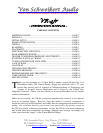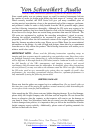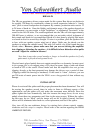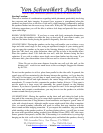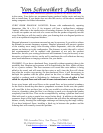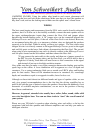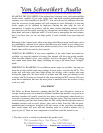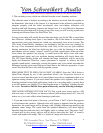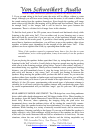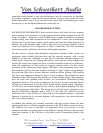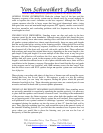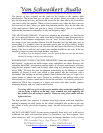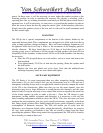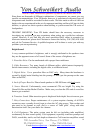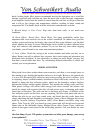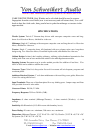
Von Schweikert Audio
930 Armorlite Drive, San Marcos, CA 92069
Ph (760)410-1650 Fax (760)410-1655
E-mail:albertvonn@aol.com
World Class Reference Speaker Systems for Music and Film
~ Website:www.vonschweikert.com
7
BI-AMPING THE VR-4 SERIES: If the tightest bass is desired, use a solid state amplifier
on the woofer modules. If you value “image float” and liquid-sounding midrange/treble
response, use a tube amplifier on the M/T’s. You will not need an outboard crossover,
since the crossovers in the speakers will still continue to work. Although it is true that
louder output can be obtained by high-pass filtering the tube amp, the loss of
transparency is usually not worth it, and the clean volume obtainable without a high-
pass crossover will be usually satisfying for anyone but a metal head. (Note: if you are a
metal head, welcome to high-end audio!) You will need a preamp that has twin outputs,
but if you have only one set, use high quality Y-jacks available from your high-end
dealer.
Balancing of the volume levels when using amps with different input sensitivities can be
accomplished by outboard level controls available from your dealer at very modest cost.
If the amplifiers have input sensitivities which are fairly close, even if they are different
brands, there will be no need for level controls.
VERTICAL BI-AMPING: If two stereo amplifiers of the same brand and model are
available, try using this method of wiring. One channel will drive the woofer module,
while the other channel of the same amplifier will drive the upper M/T’s. This wiring
may sound much better than simply switching the amp to the mono-block “bridged”
mode.
HORIZONTAL BI-AMPING: If two different stereo amps are available, one amp can
drive the woofers and the other amp, perhaps of lower power, can drive the M/T’s. This
works well with large solid state amps driving the woofers, with a smaller tube amp
driving the upper end. We have heard of systems with 200 watts per channel on the
woofers, with 20-30 watts per channel of tube power driving the M/T sections. This may
seem like an imbalance, but since the most power is needed to drive the woofers, it may
work very well!
PLACEMENT
The VR-4s are Room Interactive, meaning that the VRs were designed to work in an
average listening room, not an anechoic chamber. Speakers that measure very good in an
anechoic chamber will usually sound too bass heavy and directional when placed in a
room due to boundary effects and room gain in the bass region. The bass response of the
room (boundary gain) has been factored into the VRs, along with the reflective nature of
boundary surfaces such as wood, plaster, glass, and so forth. Since the VRs are quasi-
omnidirectional transducers, designed to be the inverse of the recording microphone,
their sound output will react with the listening room in a positive manner only if
properly placed. There are two components of sound that reach the listener’s ears:
1. The direct arrival, or initial wavelaunch of the speaker itself;



